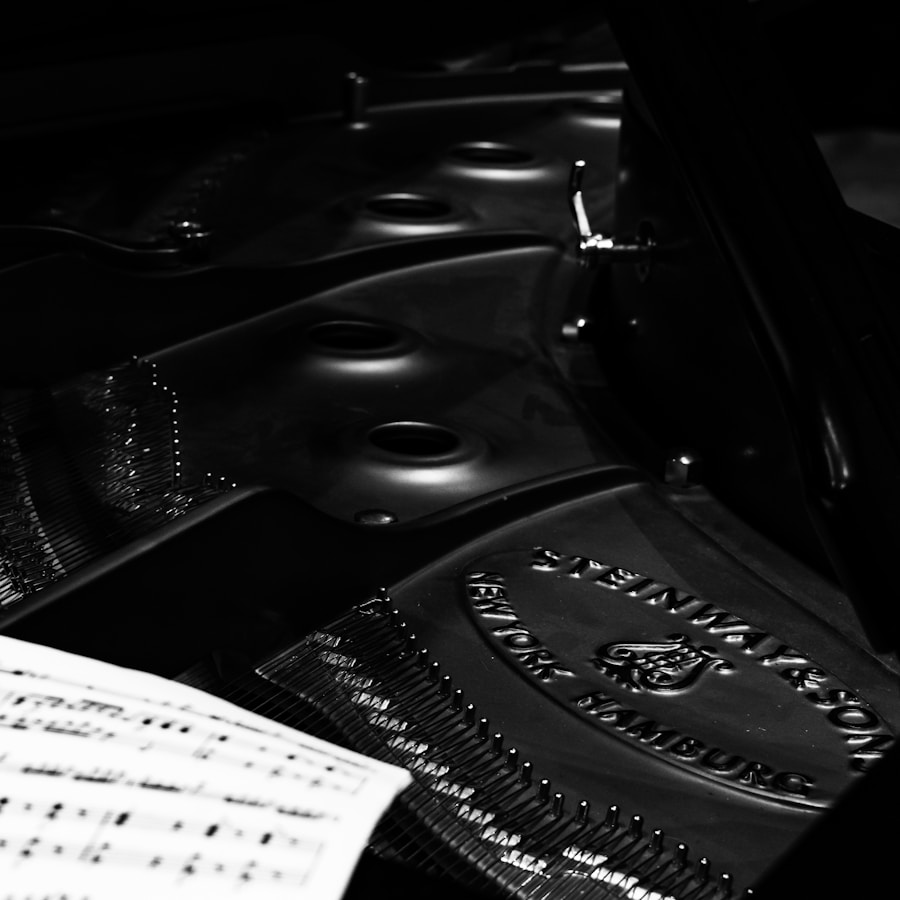Piano sheet music serves as the written language of music, providing musicians with a visual representation of notes, rhythms, and dynamics. At its core, sheet music consists of a staff, which is made up of five lines and four spaces. Each line and space corresponds to a specific musical note, allowing pianists to interpret melodies and harmonies.
The grand staff, which combines both treble and bass clefs, is commonly used for piano music, enabling players to read notes for both hands simultaneously. Understanding the structure of sheet music is essential for any aspiring pianist, as it lays the foundation for further musical exploration. In addition to the staff, various symbols and notations appear throughout sheet music to convey important information about how a piece should be played.
These include time signatures, which indicate the rhythm and beat of the music, and key signatures, which denote the scale upon which the piece is based. Other markings, such as slurs and staccatos, provide guidance on articulation and phrasing. By familiarizing themselves with these elements, pianists can gain a deeper appreciation for the nuances of a composition and enhance their overall performance.
Key Takeaways
- Understanding the basics of piano sheet music is essential for beginners to grasp the fundamentals of notation and rhythm.
- Learning to read piano sheet music involves familiarizing oneself with the staff, notes, and key signatures, as well as understanding time signatures and dynamics.
- Mastering finger placement and hand coordination is crucial for playing piano sheet music accurately and fluently.
- Practicing sight-reading techniques can improve a pianist’s ability to play music on the spot and enhance their overall musicality.
- Utilizing dynamics and expression in piano playing adds depth and emotion to a performance, enhancing the overall musical experience.
Learning to Read Piano Sheet Music
Reading piano sheet music is akin to learning a new language; it requires practice, patience, and persistence. Beginners often start by identifying the notes on the staff, associating them with their corresponding keys on the piano. This process can be facilitated by using mnemonic devices or visual aids that help reinforce note recognition.
For instance, the treble clef notes can be remembered with phrases like “Every Good Boy Deserves Fudge” for the lines and “FACE” for the spaces. Similarly, bass clef notes can be memorized using “Great Big Dogs Fight Animals” for the lines and “All Cows Eat Grass” for the spaces. As one progresses in their reading skills, it becomes crucial to develop an understanding of rhythm and timing.
This involves recognizing note values such as whole notes, half notes, quarter notes, and their corresponding rests. Counting beats aloud while playing can help solidify this understanding. Additionally, practicing with simple pieces that incorporate basic rhythms allows learners to build confidence before tackling more complex compositions.
Over time, consistent practice will lead to improved fluency in reading sheet music, enabling pianists to focus more on expression and interpretation during their performances.
Mastering Finger Placement and Hand Coordination

Finger placement and hand coordination are vital components of effective piano playing. Each finger has a designated number, with the thumb being one and the pinky being five. Proper finger positioning not only enhances technique but also contributes to overall sound quality.
Pianists are encouraged to maintain a relaxed hand posture while ensuring that their fingers are curved and poised above the keys. This allows for greater agility and control when executing various passages. Hand coordination is equally important, as it involves synchronizing both hands to create harmonious music.
Beginners often struggle with this aspect, particularly when playing pieces that require independent movement between the hands. To improve coordination, pianists can practice scales and arpeggios, focusing on evenness and fluidity in their playing. Additionally, breaking down complex pieces into smaller sections can help isolate challenging passages, allowing for targeted practice that builds confidence over time.
Practicing Sight-Reading Techniques
| Technique | Benefits | Practice Time |
|---|---|---|
| Interval Recognition | Improves pitch recognition and ear training | 10-15 minutes daily |
| Rhythm Reading | Enhances timing and rhythmic accuracy | 15-20 minutes daily |
| Sight-Reading Exercises | Develops reading fluency and musical interpretation | 20-30 minutes daily |
Sight-reading is an essential skill for pianists that enables them to play new pieces of music at first glance without prior preparation. Developing this ability requires consistent practice and a strategic approach. One effective technique is to start with simple pieces that are slightly below one’s current skill level.
This allows for a focus on reading rather than struggling with technical challenges. As proficiency increases, pianists can gradually introduce more complex compositions into their practice routine. Another valuable sight-reading strategy involves analyzing the music before playing it.
Pianists can take a moment to scan the piece for key signatures, time signatures, and any challenging rhythms or dynamics. This mental preparation helps create a roadmap for navigating the music more effectively. Additionally, practicing sight-reading in short bursts—such as 10 to 15 minutes daily—can lead to significant improvements over time.
By incorporating these techniques into their practice regimen, pianists can enhance their ability to read music fluently and confidently.
Utilizing Dynamics and Expression in Piano Playing
Dynamics play a crucial role in conveying emotion and depth in piano performances. They refer to the variations in loudness or softness of sound produced while playing. Understanding dynamic markings such as “piano” (soft) and “forte” (loud) allows pianists to interpret music more expressively.
Additionally, terms like “crescendo” (gradually getting louder) and “decrescendo” (gradually getting softer) guide performers in shaping their musical phrases. Expression goes beyond mere dynamics; it encompasses phrasing, articulation, and tempo variations that contribute to a piece’s overall character. Pianists are encouraged to listen closely to recordings of professional performances to gain insight into how dynamics and expression can transform a piece of music.
Experimenting with different interpretations during practice sessions can also help develop a personal style. By embracing dynamics and expression, pianists can elevate their performances from mere technical execution to captivating musical storytelling.
Exploring Different Styles and Genres of Piano Music

Discovering Preferences and Strengths
For instance, classical music often emphasizes technical precision and adherence to written notation, while jazz encourages improvisation and personal expression. Diving into various genres allows pianists to discover their preferences and strengths while also exposing them to different techniques and approaches.
Exploring New Techniques and Approaches
For example, learning blues piano can introduce players to unique chord progressions and rhythmic patterns that differ from classical traditions. Similarly, studying pop music may involve understanding modern chord structures and catchy melodies that resonate with contemporary audiences.
Cultivating a Well-Rounded Skill Set
By embracing diverse styles, pianists can cultivate a well-rounded skill set that enriches their musical journey.
Developing a Practice Routine for Piano Sheet Music
Establishing a consistent practice routine is essential for any pianist aiming to improve their skills effectively. A well-structured routine should include a balance of technical exercises, sight-reading practice, repertoire work, and improvisation or composition time. Setting specific goals for each practice session can help maintain focus and motivation.
For instance, dedicating time to mastering a challenging passage or refining dynamics in a particular piece can lead to measurable progress. In addition to setting goals, incorporating variety into practice sessions can prevent monotony and keep motivation high. Alternating between different pieces or styles can stimulate creativity and encourage exploration of new techniques.
Furthermore, regular self-assessment through recording practice sessions or seeking feedback from teachers or peers can provide valuable insights into areas needing improvement. By developing a thoughtful practice routine, pianists can maximize their growth while enjoying the process of learning.
Tips for Overcoming Challenges in Mastering Piano Sheet Music
Mastering piano sheet music often comes with its share of challenges, but there are effective strategies to overcome these obstacles. One common issue is frustration with difficult passages or complex rhythms. In such cases, breaking down challenging sections into smaller segments can make them more manageable.
Practicing slowly at first allows for greater accuracy before gradually increasing speed as confidence builds. Another challenge many pianists face is maintaining motivation during long practice sessions or when progress seems slow. Setting short-term goals can help create a sense of accomplishment along the way.
Celebrating small victories—such as mastering a tricky section or successfully sight-reading a new piece—can boost morale and encourage continued effort. Additionally, seeking support from fellow musicians or teachers can provide encouragement and fresh perspectives on overcoming hurdles in learning piano sheet music. By employing these strategies and maintaining a positive mindset, pianists can navigate the complexities of mastering sheet music while enjoying the journey of musical growth.
With dedication and perseverance, they will find themselves not only improving their technical skills but also deepening their connection to the art of piano playing.
If you are interested in learning more about mastering jazz improvisation, you should check out this article here. Understanding the fundamentals of jazz improvisation can greatly enhance your ability to interpret and play piano sheet music. By incorporating essential techniques for every musician, you can take your piano playing to the next level and truly express yourself through your music.
FAQs
What is piano sheet music?
Piano sheet music is a musical notation that represents the notes, rhythms, and other musical elements of a piece of music specifically written for the piano.
What do the symbols on piano sheet music mean?
The symbols on piano sheet music represent various musical elements such as notes, rests, dynamics, tempo markings, articulations, and other instructions for the pianist to follow while playing the piece.
How do you read piano sheet music?
To read piano sheet music, one must understand the musical symbols and their corresponding meanings, as well as be able to identify the notes on the staff and their respective positions on the piano keyboard.
What are the basic elements of piano sheet music?
The basic elements of piano sheet music include the staff, clefs, notes, rests, time signatures, key signatures, dynamics, and other musical symbols that convey the details of the music to the pianist.
Why is it important to learn how to read piano sheet music?
Learning how to read piano sheet music is important for pianists as it allows them to interpret and perform a wide range of musical pieces accurately and expressively. It also provides a foundation for understanding music theory and composition.





